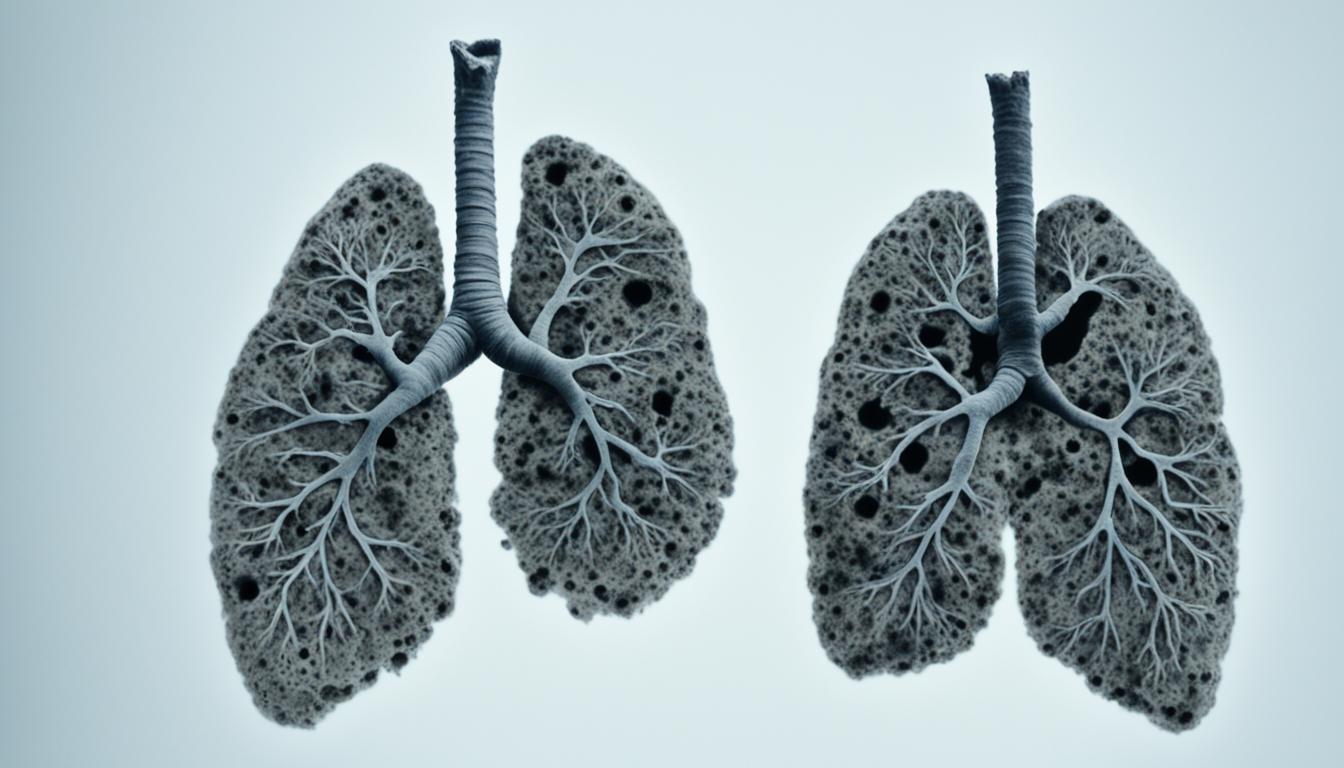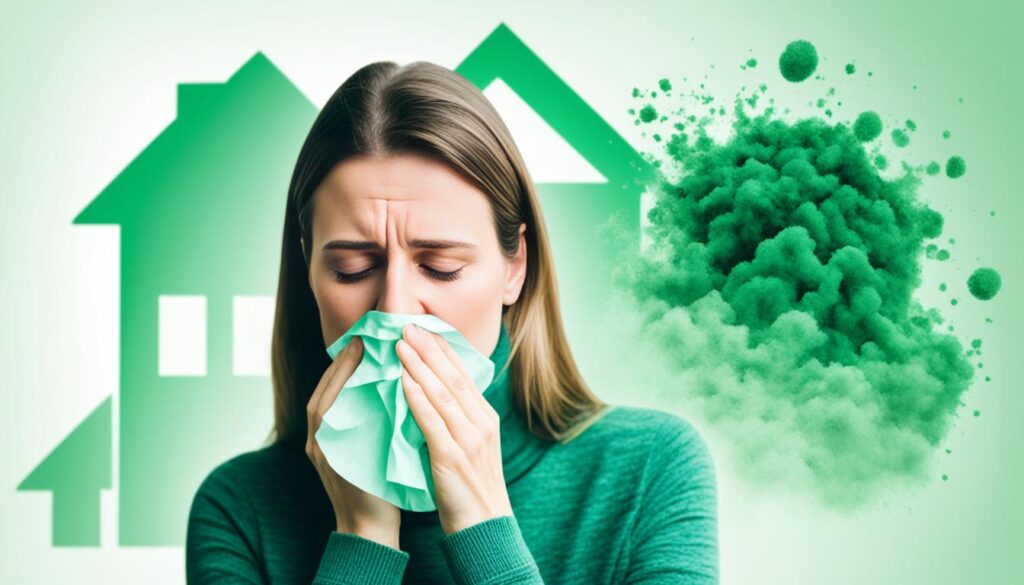
Signs of Mold Exposure in Lungs | Health Risks
When it comes to the indoor environment, mold is a significant concern. Not only can it cause structural damage to buildings, but it can also pose serious health risks to those living or working in affected spaces. One area of particular concern is the impact of mold exposure on the lungs.
Mold spores are microscopic and can be easily inhaled into the respiratory system, where they can cause various symptoms and health issues. Recognizing the signs of mold exposure in the lungs is crucial for early detection and appropriate action.
Key Takeaways:
- Mold exposure in the lungs can lead to a range of symptoms and health risks.
- Common symptoms include coughing, wheezing, shortness of breath, and chest tightness.
- Mold exposure can increase the risk of respiratory infections such as bronchitis or pneumonia.
- Individuals with mold allergies may experience allergic reactions when exposed to mold spores.
- Those with asthma can experience worsened symptoms and asthma attacks due to mold exposure.
Understanding Mold Exposure in the Lungs
In this section, we will delve deeper into the effects of mold exposure on the lungs. It is crucial to understand how mold spores can enter the respiratory system and the potential consequences it can have on respiratory health.
Mold is a common problem in indoor environments, and when left unaddressed, it can lead to various health issues, particularly affecting the lungs. Mold spores, which are tiny and airborne, can be inhaled and reach the different parts of the respiratory system, including the nasal passages, throat, and lungs. Once inside the lungs, these spores can trigger an immune response, causing a range of symptoms and potentially leading to lung infections.
“The adverse effects of indoor mold on respiratory health cannot be overstated. Mold exposure in the lungs can seriously impact the quality of life and lead to chronic respiratory conditions.”
It is important to recognize and address mold issues in the indoor environment promptly. Identifying the presence of mold, determining the source of moisture or humidity that supports its growth, and taking appropriate remedial measures can help prevent further exposure and safeguard respiratory health.
To highlight the significance of understanding mold exposure in the lungs, let’s take a closer look at the potential consequences it can have:
| Effects of Mold Exposure on the Lungs | Risks |
|---|---|
| Allergic reactions | Individuals with mold allergies may experience allergic rhinitis, asthma exacerbation, or other allergic reactions when exposed to mold spores. |
| Asthma exacerbation | Mold exposure can worsen asthma symptoms and trigger asthma attacks in individuals with existing asthma. |
| Hypersensitivity pneumonitis | Prolonged exposure to mold can lead to hypersensitivity pneumonitis, an inflammatory lung disease. |
| Fungal infections | In some cases, mold exposure can result in fungal infections, such as aspergillosis or invasive pulmonary fungal infections. |
Recognizing the signs of mold exposure in the lungs and taking proactive measures to address mold issues in the indoor environment are crucial in maintaining optimal respiratory health. If you suspect mold in your home or workplace, it is recommended to seek professional assistance for mold assessments and remediation. Early detection and timely action can significantly mitigate the risks associated with mold exposure in the lungs.
Common Symptoms of Mold in the Lungs
Exposure to mold in the lungs can cause a range of symptoms that individuals should be aware of. Recognizing these symptoms is crucial for early detection and prompt medical intervention. Common symptoms of mold in the lungs include:
- Coughing: Persistent coughing is a common symptom of mold exposure in the lungs. This cough may be dry or productive and may worsen over time.
- Wheezing: Wheezing, a whistling sound while breathing, can occur when mold spores irritate the airways. It may be accompanied by difficulty breathing.
- Shortness of Breath: Mold exposure can lead to shortness of breath, making it challenging to catch one’s breath or fully expand the lungs.
- Chest Tightness: Individuals exposed to mold in their lungs may experience a sensation of constriction or tightness in the chest.
Mold-related lung issues can also increase the risk of developing respiratory infections. The presence of mold weakens the respiratory system, making individuals more susceptible to infections such as bronchitis or pneumonia. If left untreated, these infections can lead to further complications.
To better understand the symptoms of mold in the lungs, it’s important to consult a healthcare professional for an accurate diagnosis and appropriate treatment. Early intervention can help prevent further damage to the respiratory system.
Quote:
“The symptoms of mold in the lungs should never be ignored. Seeking medical attention promptly is crucial to prevent long-term complications and ensure proper respiratory health.” – Dr. Jane Miller

Health Risks Associated with Mold in the Lungs
Exposure to mold in the lungs can pose several health risks, ranging from allergic reactions to more severe conditions. Understanding these risks is crucial for individuals who may be exposed to mold in their environment.
Mold allergies can cause individuals to experience allergic reactions when exposed to mold spores in the air. The immune system reacts to these allergens, leading to symptoms such as sneezing, itching, watery eyes, and nasal congestion.
“Individuals with pre-existing asthma are particularly susceptible to asthma exacerbation when exposed to mold spores,” says Dr. Emily Roberts, a pulmonologist at the National Institute of Allergy and Infectious Diseases. Mold exposure can worsen asthma symptoms and trigger asthma attacks, making it essential for asthmatics to minimize their exposure to mold.
“Hypersensitivity pneumonitis is a serious condition that can occur due to prolonged or significant mold exposure,”
says Dr. Jennifer Smith, an expert in occupational lung diseases. This condition is characterized by inflammation of the lungs, leading to symptoms such as shortness of breath, cough, and fatigue. It is crucial to identify and address mold issues promptly to prevent the development of hypersensitivity pneumonitis.”
In rare cases, mold exposure in the lungs can result in fungal infections. When individuals breathe in mold spores, the spores can settle and grow in the respiratory system, causing infections such as aspergillosis or fungal pneumonia. These infections can be severe, especially in those with weakened immune systems.
It is important to note that the severity of health risks associated with mold in the lungs can vary depending on factors such as the individual’s overall health, duration of exposure, and the type of mold present. Seeking prompt medical attention and addressing mold issues in the environment are essential for preventing complications.

Conclusion
In conclusion, mold exposure in the lungs can have significant implications for your respiratory health. Being aware of the signs and symptoms indicating mold-related lung issues is crucial in taking appropriate measures for prevention and remediation. If you suspect mold in your indoor environment, it is strongly recommended to seek professional assistance, such as Fix Mold Miami. They specialize in providing thorough mold assessments and expert guidance for prevention and remediation.
Remember, early detection and prompt action can play a crucial role in protecting your respiratory health and preventing further complications. Don’t ignore any persistent respiratory symptoms or signs of mold in your surroundings. Taking proactive steps to address mold issues can make a significant difference in maintaining a healthy living environment.
By addressing mold-related lung issues promptly, you can mitigate risks such as allergic reactions, asthma exacerbations, and even severe conditions like hypersensitivity pneumonitis or fungal infections. Protecting your respiratory health should be a top priority, and seeking professional help can ensure thorough assessment, effective prevention, and proper remediation for a mold-free living space.




